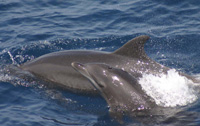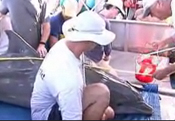Bottlenose Dolphin (Tursiops truncatus)

Bottlenose Dolphins
(Tursiops truncatus)
Photo: NOAA Southwest
Fisheries Science Center

Bottlenose Dolphin Range Map
(click for larger view PDF)
Did You Know?
- Feeding wild dolphins is harmful and illegal - Florida tour boat operator fined $4,500
- Unusual Mortality Events ongoing since 2013 for Bottlenose Dolphins in Florida and Mid-Atlantic
- Unusual Mortality Event ongoing since 2010 in the Northern Gulf of Mexico
- Females as old as 45 years have given birth!
- Bottlenose dolphins employ a feeding strategy called "fish whacking," where they strike a fish with their flukes and knock it clear out of the water.
- Dolphins are born with a few hairs on their "rostrum" that they lose shortly after birth.
CITES Appendix II - throughout its range
|
Weight:
|
300-1400 lbs (135-635 kg) |
|
Length:
|
6.0-12.5 ft (~2-4 m) |
|
Appearance:
|
light gray to black |
|
Lifespan:
|
40-50 years; sexual maturity varies by population but ranges from 5-14 years of age |
|
Diet:
|
invertebrates, squids, fishes |
|
Behavior:
|
use high frequency echolocation to locate and capture prey; use multiple feeding strategies, including "fish whacking," where they strike a fish with their flukes and knock it out of the water |
The bottlenose dolphin is one of the most well known species of marine mammals. They have a robust body and a short, thick beak. Their coloration ranges from light gray to black with lighter coloration on the belly. Inshore and offshore individuals vary in color and size. Inshore animals are smaller and lighter in color, while offshore animals are larger, darker in coloration and have smaller flippers. Bottlenose dolphins can sometimes be confused with the rough-toothed dolphins, Risso's dolphins, and Atlantic spotted dolphins in regions of overlapping distributions.
Bottlenose dolphins range in lengths from 6.0 to 12.5 ft (1.8 to 3.8 m) with males slightly larger than females. Adults weight from 300-1400 lbs (136-635 kg). This is a long-lived dolphin species with a lifespan of 40-45 years for males and more than 50 years for females.
Bottlenose dolphins are commonly found in groups of 2 to 15 individuals. Offshore herds sometimes have several hundred individuals. This species is often associated with pilot whales and other cetacean species.
Bottlenose dolphins are generalists and feed on a variety of prey items "endemic" to their habitat, foraging individually and cooperatively. Like other dolphins, bottlenose dolphins use high frequency echolocation to locate and capture prey. Coastal animals prey on "benthic" invertebrates and fish, and offshore animals feed on pelagic squid and fish. Bottlenose dolphins employ multiple feeding strategies, including "fish whacking," where they strike a fish with their flukes and knock it out of the water.
Sexual maturity varies by population and ranges from 5-13 years for females and 9-14 years for males. Calves are born after a 12 month gestation period and are weaned at 18 to 20 months. On average, calving occurs every 3 to 6 years. Females as old as 45 years have given birth.
Bottlenose dolphins are found in temperate and tropical waters around the world. There are coastal populations that migrate into bays, estuaries and river mouths as well as offshore populations that inhabit pelagic waters along the continental shelf. The bottlenose dolphin has a worldwide distribution ranging from latitudes of 45°N to 45°S.
Winter, the tailless dolphin [pdf]
Credit: Clearwater Marine Aquarium

Scientists assess the health of dolphins in Barataria Bay, LA, part of NOAA's ongoing efforts following the Deepwater BP oil spill
NBC Nightly News video
Credit: msnbc.com

Rio, a Chronically Entangled Dolphin in the Indian River Lagoon [pdf]
Photo: Hubbs-SeaWorld
- incidental injury and mortality from fishing gear, such as gillnet, seine, trawl, and longline commercial and recreational operations
- exposure to pollutants and biotoxins
- viral outbreaks
- direct harvest, in Japan and Taiwan
NOAA and its local, state and federal partners started the Barataria Bay dolphin study in 2011 as part of the Natural Resource Damage Assessment (NRDA), the process for studying the effects of the Deepwater Horizon oil spill.
In 2006, NMFS implemented the Bottlenose Dolphin Take Reduction Plan (BDTRP) to reduce the serious injury and mortality of Western North Atlantic coastal bottlenose dolphins incidental to nine U.S. commercial fisheries. In addition to multiple non-regulatory provisions for research and education, the BDTRP requires modifications of fishing practices for small, medium, and large-mesh gillnet fisheries from New York to Florida. The BDTRP also established seasonal closures for certain commercial fisheries in state waters.
Bottlenose dolphins are classified as Data Deficient on the IUCN Red List ![]() .
.
Phylum: Chordata
Class: Mammalia
Order: Cetacea
Family: Delphinidae
Genus: Tursiops
Species: truncatus (All documents are in PDF format.)
| Title | Federal Register | Date |
|---|---|---|
| 12-Month Finding on a Petition To List Bottlenose Dolphin in Fiorland, New Zealand as Threatened or Endangered Under the ESA | 80 FR 35306 | 06/19/2015 |
|
90-Day Finding on a Petition to List Multiple Species and Subpopulations of Marine Mammals under the ESA |
79 FR 9880 | 02/21/2014 |
| Bottlenose Dolphin Take Reduction Plan (BDTRP) | 71 FR 24776 | 04/26/2006 |
| Depleted Designation for Western North Atlantic Coastal Migratory Stock | 58 FR 17789 | 04/06/1993 |
|
56 FR 40594 | 08/15/1991 |
|
54 FR 41654 | 10/11/1989 |
| Stock Assessment Reports | n/a | various |
- NOAA National Marine Mammal Laboratory Bottlenose Dolphin Information
- NOAA Southeast Regional Office Bottlenose Dolphin Information
- NOAA Southwest Fisheries Science Center Bottlenose Dolphin Information
- NOAA's National Marine Sanctuaries
- Bottlenose Dolphin Take Reduction Plan (BDTRP)
- Unusual Mortality Event Along the Florida Panhandle in 2004
- Marine Mammal Commission Bottlenose Dolphin Information
- Ocean Biogeographic Information System (OBIS-SEAMAP) Bottlenose Dolphin Species Profile

Updated: January 16, 2015


